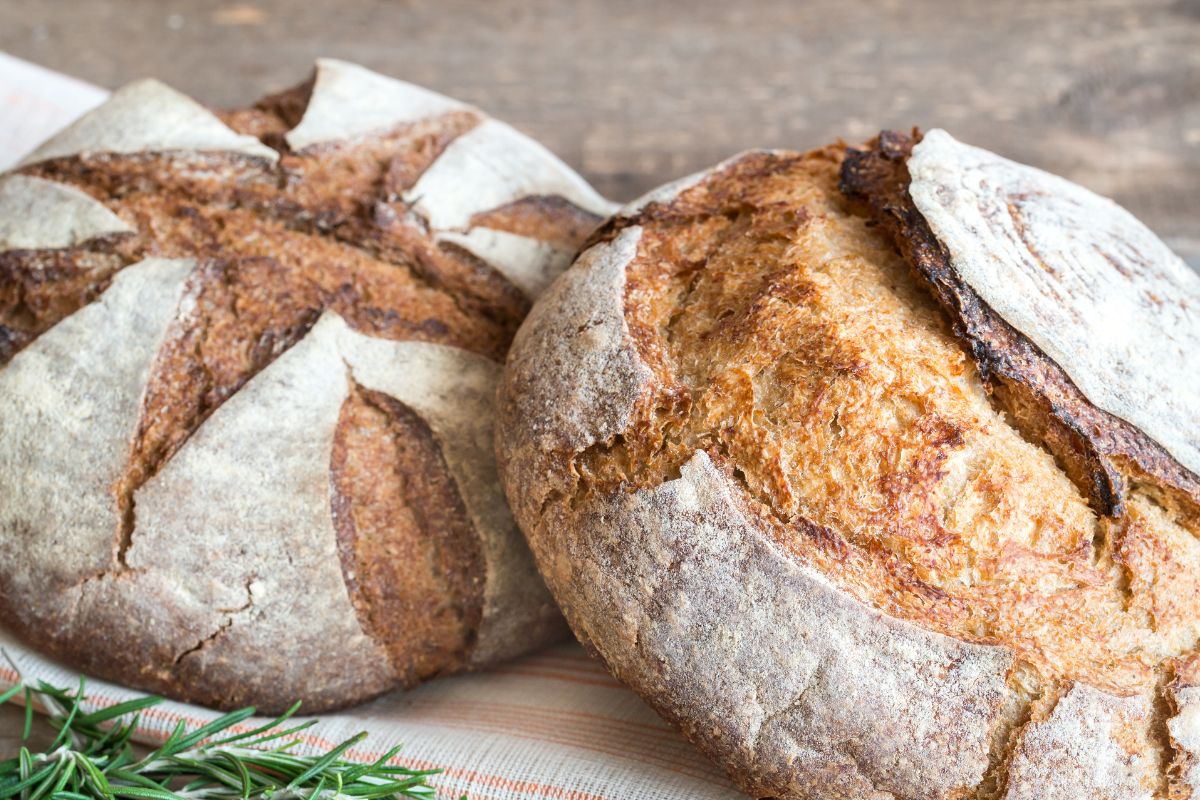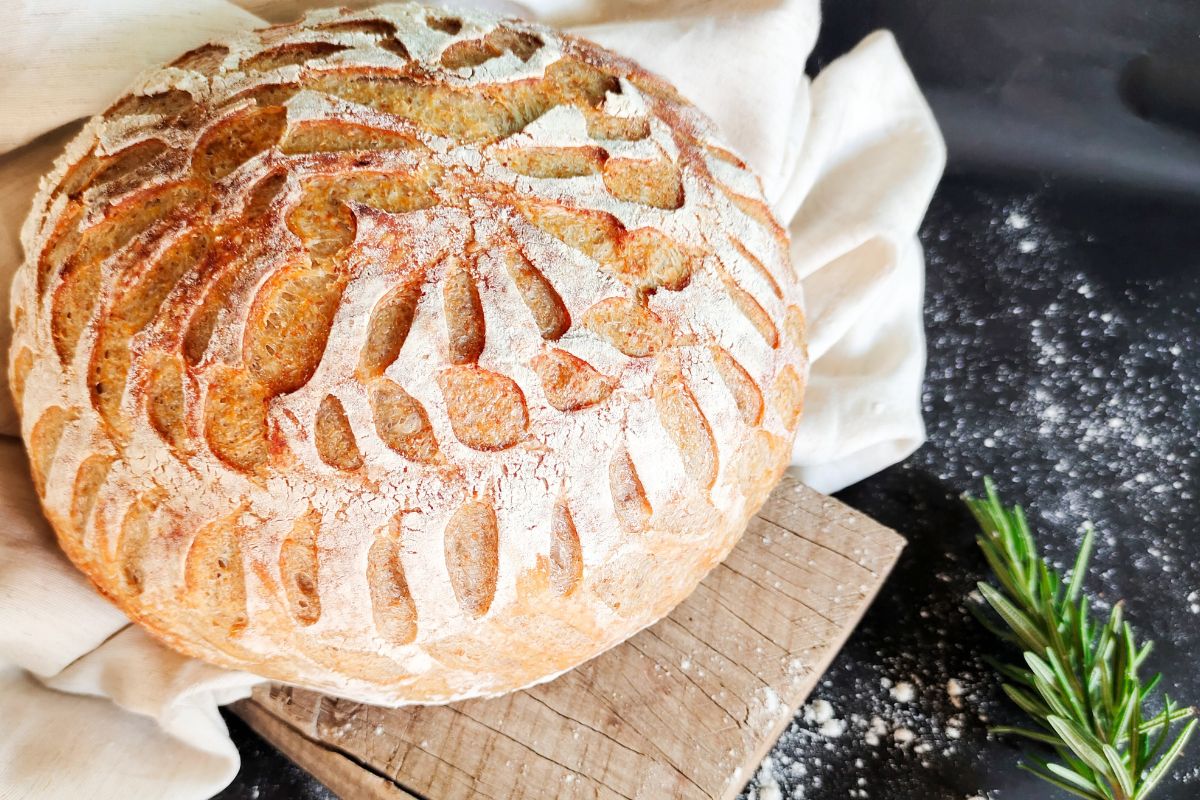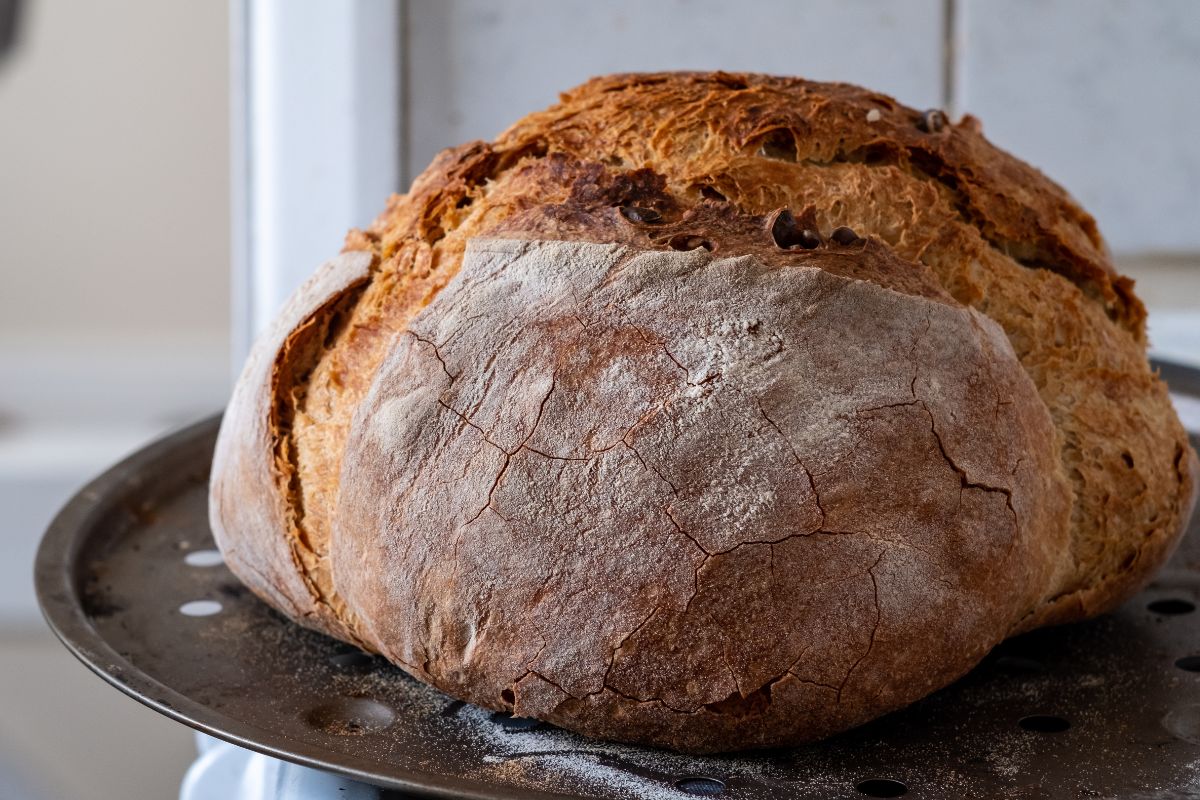What is Sourdough Bread?
If you love sourdough bread, you must have, at some point, thought about the best way to store sourdough bread. It is bread made through a natural fermentation process using a starter (a mixture of yeast, flour, and water) or “sourdough culture.”
Sourdough bread is popular for its unique tangy flavor, chewy texture, and characteristic air pockets in the crumb. This article explores how to store fresh sourdough bread without compromising its taste. Let’s dive in.

What is the Best Way to Store Sourdough Bread?
The best way to store sourdough bread to maintain its freshness and quality depends on how quickly you plan to consume it. Here are some guidelines for storing sourdough bread:
Short-Term Storage (One to Two Days)
If you plan to consume the bread within one to two days, you must know how to store sourdough bread overnight. The best option is to keep it at room temperature, preferably in a bread box or a paper bag.
Longer-Term Storage (Two to Five Days)
If you need to store sourdough bread for a few more days, it’s best to wrap it in a clean cloth or a kitchen towel and keep it at room temperature. This will help maintain the crust’s texture while preventing it from drying out too quickly.
Freezing For Extended Storage (Up to Three Months)
To keep sourdough bread fresh for an extended period, you can freeze it. But how do you store sourdough bread in a freezer? First, slice the bread if you haven’t already, as it will be easier to thaw and consume smaller portions.
Wrap the slices or the whole loaf tightly in aluminum foil or plastic wrap, then place it in a resealable plastic bag. Put a label on the plastic bag with the date to monitor its freshness.
When you want to enjoy the bread, simply take out the desired slices and thaw them at room temperature or use a toaster or oven to reheat them.
Avoid Refrigeration
Refrigerating sourdough bread is generally not advisable as it can lead to faster staling. The bread may become dry and lose its texture due to the cold temperature.
Reviving Stale Bread
If your sourdough bread becomes slightly stale, you can refresh it by sprinkling some water on the crust and reheating it in the oven for a few minutes. This can help restore some of its crustiness.
Remember that sourdough bread is best enjoyed fresh, so try to consume it within the first couple of days after baking. The above storage methods are helpful if you have leftover bread or need to plan for longer storage periods.
How Long Does Sourdough Bread Last?
Although sourdough bread doesn’t mold quickly, it loses its freshness after 24 hours, even if it can last for several days. The shelf life of sourdough bread can vary depending on how it’s stored and the specific ingredients used.
On average, sourdough bread can last between two to five days if stored properly. After day five, your sourdough bread will be stale (but not moldy). Be sure to check for any signs of spoilage, such as mold, off odors, or unusual discoloration, before consuming sourdough bread stored for an extended period.
How to Store Sourdough
Properly storing sourdough is crucial to maintain its freshness, texture, and flavor. Here are the steps to store sourdough bread:
Plastic Bag
This is, without a doubt, the best method for preserving sourdough bread. These bread bags will keep your loaf fresh for more than a week. These bags are also a fantastic way to give bread as gifts.
Linen Bag
A bread bag made of linen is adorable and useful. You may create your own from fabric scraps or look for cute patterns on Etsy. Cloth has only one drawback: it lets air circulate the bread, which might hasten its staleness.
Brown Paper Bag
This is yet another fantastic bag choice. Compared to plastic bags, this variant will cost a little more. These also make lovely gift bags and give the impression that the bread just left the bakery.
Plastic Wrap
You can preserve your bread quickly and efficiently using plastic cling wrap. When it has cooled, wrap it in several layers to keep it fresh for several days.
Bread Boxes
A bread box can be a convenient container for your bread. It keeps the bread off the kitchen counter and might contribute to your pantry decor.
Aluminum Foil
Aluminum foil is a fantastic alternative to plastic cling wrap for storing sourdough.
Tea Towel
Leave the bread on the cutting board if you anticipate using it within a day or two. Place the loaf cut side down and cover with a tea towel. The inside will remain soft, while the outside will remain crisp. This approach will only work for a few days before drying out and becoming stale.
Cake Dome Plate
This approach works well and improves the appearance of your house. It looks beautiful on a kitchen counter or a dinner table. Additionally, the dome helps protect the bread from moisture and air.

Can Sourdough Bread be Frozen?
Yes! You can freeze sourdough bread to extend its shelf life. Freezing sourdough bread is an excellent way to preserve freshness and enjoy it later. Here is how to keep fresh sourdough bread fresh by freezing:
- Slice the bread (optional): If the sourdough bread is unsliced, you may want to slice it before freezing. Cutting the bread makes thawing and consuming smaller portions at a time easier.
- Wrap the bread tightly: Use plastic or aluminum foil to wrap the whole loaf or individual slices tightly. Ensure there are no air pockets, which can lead to freezer burn.
- Place in a resealable plastic bag: After wrapping the bread, place it inside a resealable plastic bag or an airtight container. Label the bag with the date to keep track of its freshness.
- Freeze quickly: Put the wrapped and sealed sourdough bread in the freezer immediately. The quicker it freezes, the better it will retain its quality.
- Thawing and consuming: When you want to enjoy the frozen sourdough bread, remove the desired slices from the freezer and let them thaw at room temperature. Alternatively, you can use a toaster or oven to reheat the pieces for a few minutes until they are warm and crispy.
Beyond that, the bread is still safe to eat, but its quality might deteriorate. Freezing is a convenient way to have delicious sourdough bread on hand without worrying about it going stale whenever you crave it.
How to Store Sourdough Bread After Cutting
After cutting sourdough bread, it’s essential to store it properly to prevent it from drying out and maintain its freshness. Here’s how to store sourdough bread after cutting:
- Wrap it tightly: After slicing the sourdough bread, wrap the cut side tightly in plastic or aluminum foil. Ensure there are no exposed edges or gaps where air can get in, as air exposure can lead to the bread drying out quickly.
- Store at room temperature: If you plan to consume the bread within a day or two, you can store it at room temperature. Place the wrapped bread on a cutting board or in a bread box to protect it from excess air exposure.
- Reheat when needed: You can reheat cut sourdough bread if it starts to lose its freshness or go a little stale to bring back some of the texture and crust. You should warm the slices in the oven or toaster for a few minutes to become toasty and crispy.
- Freezing for longer storage: If you don’t plan to consume the bread within a day or two, it’s best to freeze it. Follow the steps mentioned in the section above for freezing sourdough bread: slice it, wrap it tightly in plastic or aluminum foil, and place it in a resealable plastic bag or airtight container. Label the bag with the date for easy tracking.
Frequently Asked Questions
What is Sourdough Starter
The sourdough starter is a mixture of flour and water that captures wild yeast and beneficial bacteria from the environment. Over time, these microorganisms ferment the mixture, producing carbon dioxide gas, which causes the bread to rise. The lactic acid bacteria in the starter also contribute to the distinctive sour taste of the bread.
How Do I Make Sourdough Bread?
The process of making sourdough bread typically involves several steps:
- Creating the starter: Mix flour and water and allow it to ferment over several days to capture the wild yeast and bacteria. The starter needs regular feeding to maintain its activity.
- Preparing the dough: Combining the starter with more flour, water, and sometimes salt to create the sourdough bread dough.
- Bulk fermentation: Allowing the dough to rest and rise for several hours to develop flavor and structure.
- Shaping: Shaping the dough into the desired loaf or other forms.
- Proofing: Allowing the shaped dough to rise again before baking.
- Baking: Baking the proofed dough at high temperatures activates the leavening agents and gives the bread its final texture and crust.

The Final Say
Sourdough bread has gained popularity for its distinct taste, natural fermentation process, and potential health benefits. Some people with gluten sensitivity find sourdough bread easier to digest due to the longer fermentation process, which partially breaks down gluten proteins.
Unlike traditional bread, which relies on commercial yeast for leavening, sourdough bread gets leavened by wild yeast and lactic acid bacteria in the sourdough starter. After reading this text, we hope you learned new ways to keep your sourdough bread fresh longer.

Community of passionate writers and content creators who share a love for Italian heritage, culture, travel, food, and the Italian-American community. Our mission is to celebrate Italy’s rich history and traditions and connect with others who share the same passion.

